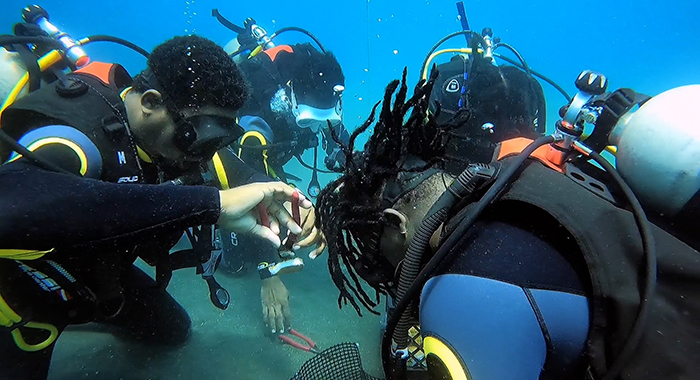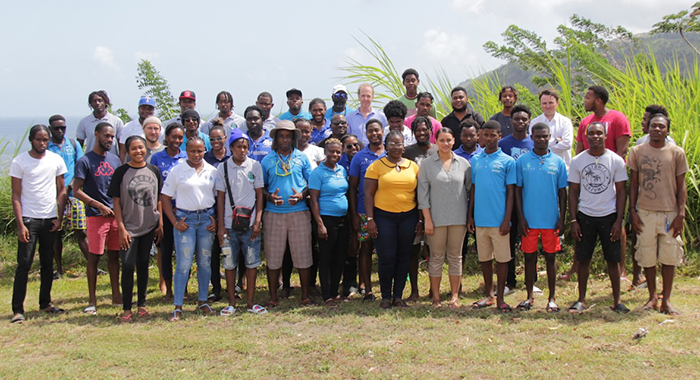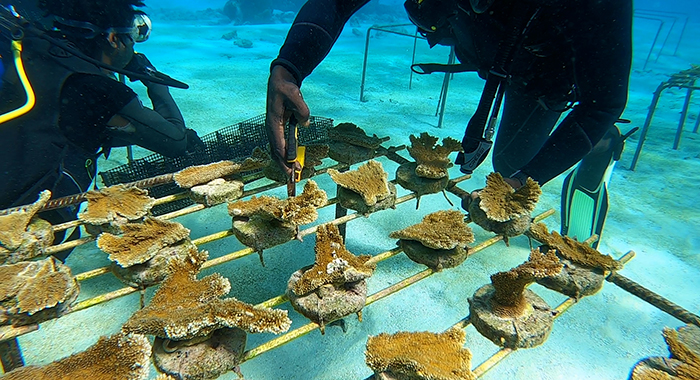A coral restoration project in St. Vincent and the Grenadines (SVG) is reporting significant success, with more than 85% of the fragments transplanted so far surviving.
Owen Day, executive director of CLEAR Caribbean, a not-for-profit organisation working in the Eastern Caribbean, explained that his organisation has been working in partnership with the Richmond Vale Academy (RVA), Sustainable Grenadines, and We Are Mayreau on the project to scale up coral restoration in the Eastern Caribbean.
The project, which is funded by the Caribbean Biodiversity Fund through their ecosystem-based adaptation facility, is restoring the populations of elkhorn and staghorn corals, which are critically important for the ecology of Caribbean reefs.
“Today, they’re quite hard to find; quite, quite rare, especially staghorn,” Day said, adding that before the 1950s, elkhorn and staghorn coral were extremely abundant.
He said the corals are incredibly important for fish, lobsters and invertebrates and it is believed that the initial decline of the corals resulted from the use of pesticides in the banana industry.
Then, in the 1980s, there was another big decline in elkhorn and staghorn population because of the devastating White Band Disease, which may have been brought to the region through the Panama Canal in the ballast water of ships.
“It killed 95% of these two coral species — elkhorn and staghorn. And then on top of that you had hurricanes, you had other diseases affecting sea urchins,” Day said, adding that the reefs took a hammering in the 80s, and 90s.
“And today, we see the result is that elkhorn and staghorn really are on their last legs as well.”
The coral restoration programme is to find the resilient survivors and propagate them. This involves growing coral fragments in underwater nurseries, propagating fragments in large numbers, then planting them back on the reef.
“And the idea is to plant not only thousands or ten of thousands, possibly hundreds of thousand, but also to make sure that they reproduce sexually,” he said, noting that coral are hermaphrodite animals that spawn at full moon once a year.
“So, it’s an exciting programme. And perhaps the most exciting part for me is that the communities are really jumping on this and we’re training, so far, 35 local men and women to be coral gardeners. And they are doing an amazing job,” Day said.
Currently, CLEAR Caribbean is working on sites in St. Vincent, three sites in the Grenadines, and also in St. Lucia and has planted over 10,000 corals in the 14 months since the project started.
Tobias Herberg, the coral project leader at RVA, said 16 locals are involved in the project. To participate in the project, they receive PADI Open Water Diver certification and technical training on coral restoration. The construction and erect undersea structures that are made of steel or PVC, on which the coral fragments are attached and left to grow before being transplanted on the reef.

Herberg said that during their dives to search for coral colonies they did not find any staghorn coral in the waters of St. Vincent. They were able to get some fragments from We Are Mayreau and Sustainable Grenadines in Union Island, located in the southern Grenadines, which they brought back to St. Vincent.
“We are lucky enough that the elkhorn fragments are all over the coastline of mainland St. Vincent so there we had a little bit easier type of work,” Herberg explained.
He said his team wants to collect as many different genotypes to ensure genetic diversity of the elkhorn fragments, which will improve their future resilience and reproduction when they are transplanted onto the reefs.
The awareness includes taking students to the nursery sites in glass-bottom boats so they can see the coral restoration work first-hand and learn about the importance of corals to the ecosystem.
RVA’s coral nurseries are located in Troumaca Bottom, Cumberland, Kearton and Buccament.
“I would say at least 85% of all of the fragments survive. And we see the same with the out planting that we have started now. Between 85 and 90% of what we have out planted, which is a little bit more than 400 fragments, are still alive. And it’s a very good sign for us to see that the success rate is so high because then we also know that we can continue expanding these practices with good success,” Herberg said.
The coral gardeners include Danica DeRoche, of Kingstown, and Nemrom Miller, of Layou, both of whom spoke highly of the project.
DeRoche enrolled in the coral restoration project in 2021, after returning from Belize, where she completed her internship under RVA’s Fighting with the Poor programme, which is focused on helping communities to respond to climate change.
“It has become a passion instead of a job where I get really, really sad if a coral dies. Or if it starts bleaching or if I don’t get to clean the trees, all the trees, I get really worried,” DeRoche said.
DeRoche’s job involves keeping the corals clean in the nursery.
“… it’s really hard for me to look at it as a job because they’re like my babies. And obviously when you have a child, you’re not going to want your child to get sick or die or anything of that sort,” she said.
“I’m absolutely overjoyed with this project. It gives me comfort, peace of mind. I’m very content. Everybody’s looking for office jobs and I’m here having the best time of my life. And I’m sure a lot of people are jealous of my job. That’s a plus for me.”

Miller, who had been diving for a long time before enrolling in the project, recounted that his brothers had told him about the amount of corals that used to be in the waters of St. Vincent and the Grenadines.
“… and I didn’t meet that much … So, I’ve seen the impact that we’ve caused — each of us our part that we play to destroy the ocean, also the land,” Miller said.
“So, now with this coral restoration, we just hope that we can restore the diversity in the ocean, whether it’s to bring back more fishes to the coastlines and from heavy waves, hurricanes, like all these types of stuff.”
He said he has always dreamt of “doing something positive for the environment and for the world, especially my country”, adding that young people can do whatever little they can from the environment by starting somewhere.
“I won’t lie. I feel really fulfilled. I know I still have more to do, but I really enjoy it. I love it so much. I swear this is the first time in my life I actually feel like I’m doing something that is actually impacting something,” Miller said.
Meanwhile, Kris Isaacs, senior fisheries officer in the Ministry of Fisheries, explained that coral reefs are a very important marine resource, in SVG and the Caribbean.
“Whether it be economic in the tourism industry, or fisheries sector like myself; whether you’re looking at the beauty of coral reefs from a recreational point of view, or you’re looking at the protection that coral reefs give to coastal areas, it’s definitely a resource that is worth looking at, worth preserving for future generations.”
He said this is why the coral restoration initiative is so important for the region and SVG, noting that corals have declined over the past decades because of climate change, industrial pollution, sedimentation and common diseases.
“And, therefore, steps need to be taken, initiatives need to be had, where we can look at the coral reefs and try to restore them, if not in the traditional locations, then looking at other locations. And this initiative is definitely using that and using what we like, a community approach. by getting our stakeholders involved, by getting the Vincentian public involved,” Issacs said.
He said that by using a community approach, the project team can get the buy-in of fishers and community members.
“But as a nation, we look at this important resource will look at the ways in which we can solve some of the issues for not only our present generation, but future generations to come for bigger, brighter St. Vincent and Grenadines,” Issacs said.







Very impressive.
Owen Day comes across as too goodie-two-shoes and Kenton Chance is too professional to thumb their nose at, well, anyone, but this story sure thumbs its nose at the carpetbagger and his foreign crew who proposed a plan that would have killed off the Indian Bay reef.
Owen Day and CLEAR Caribbean, along with Richmond Vale Academy, are shining examples of the “teach-a-man-to-fish” proverb as they work to build sustainable solutions. While, on the other hand, the carpetbagger and his motley gang who are focused solely on their own interests were prepared to do just the opposite to the reef at Indian Bay. They would learn you cannot eat money. Ay, with the Indian Bay reef in their hands, that lesson would have been at our expense.
Oh, talking about motley gangs it reminds me, can somebody tell Royal Mill to update their website because their promise to deliver Resort by the “end of 2022” done gone. Or haven’t they noticed? Or they think we haven’t? Updating should be easy for them because they have practice.
There has been an issue in the Caribbean with something called “diadema urchin mortality syndrome” which has caused a decline in the population of diadema sea urchins. This syndrome is caused by a variety of factors, including disease and environmental stressors such as pollution.
Diadema sea urchins play an important role in the health of coral reefs. They feed on algae that grows on the reefs, preventing it from overgrowing and smothering the coral. This process helps to maintain a healthy balance between the various organisms on the reef and promotes the growth and survival of coral communities.
Without the presence of diadema sea urchins, algae can grow out of control, leading to negative consequences such as reduced coral growth, decline in biodiversity, and reduced fish populations. Therefore, the decline in the population of diadema sea urchins is a concerning issue for the health and sustainability of Caribbean coral reefs. SVG… Its happening here now. Who is doing anything about it or even looking into the problem? The reefs are suffering.
There’s no sense doing all this work when sand mining from the sea beads are being allowed to happen. If you advocating for health sea beds, such as corals and fisheries then you can’t only focus your resources only in one area. Focusing on all the areas affecting this environmental issues MUST be considered and actively discussed and pushed for governing policies to protect this very valuable environment and be extremely enforceable by laws. It seems that environmental issues are being overlooked for the sake of more profitable outcome.